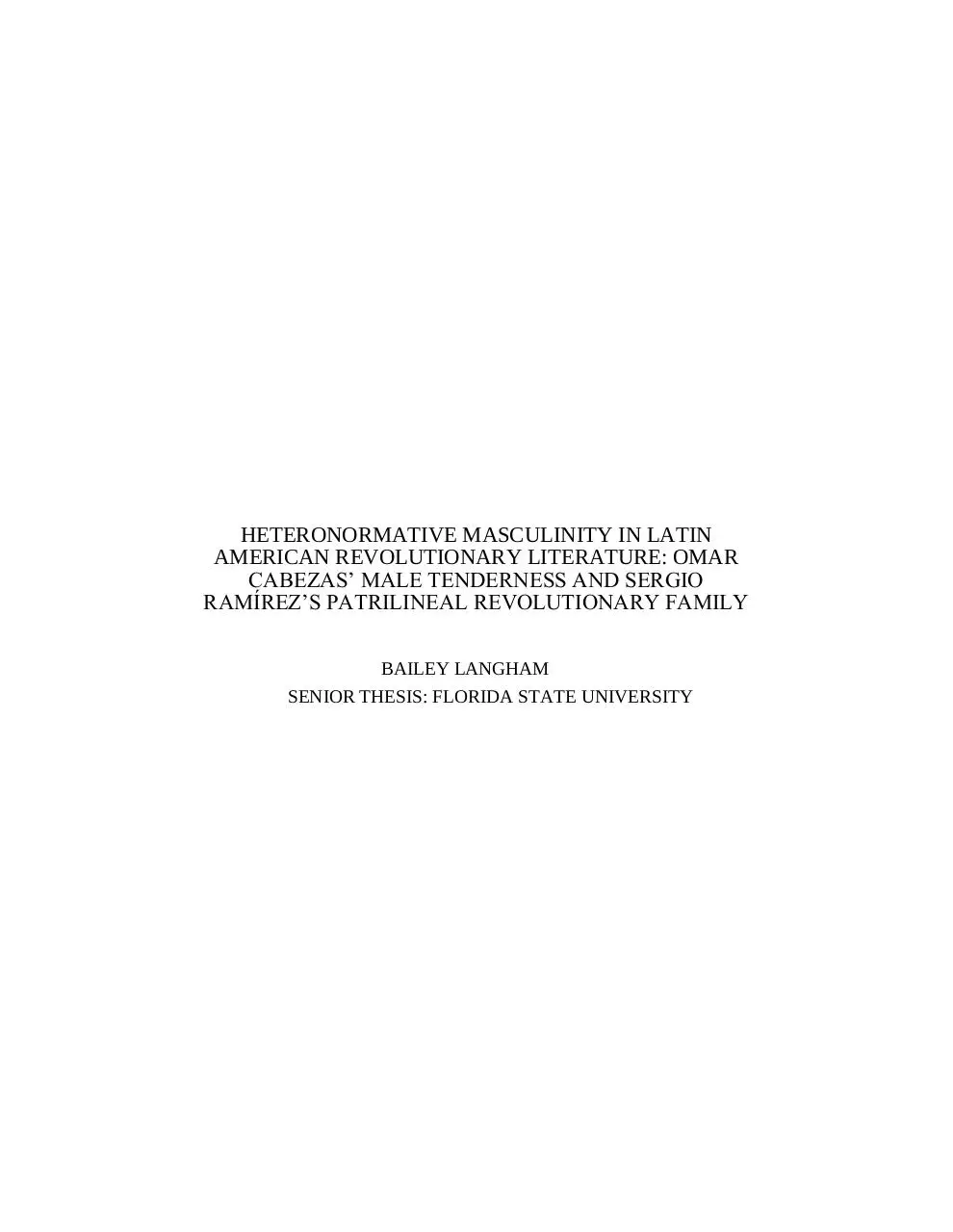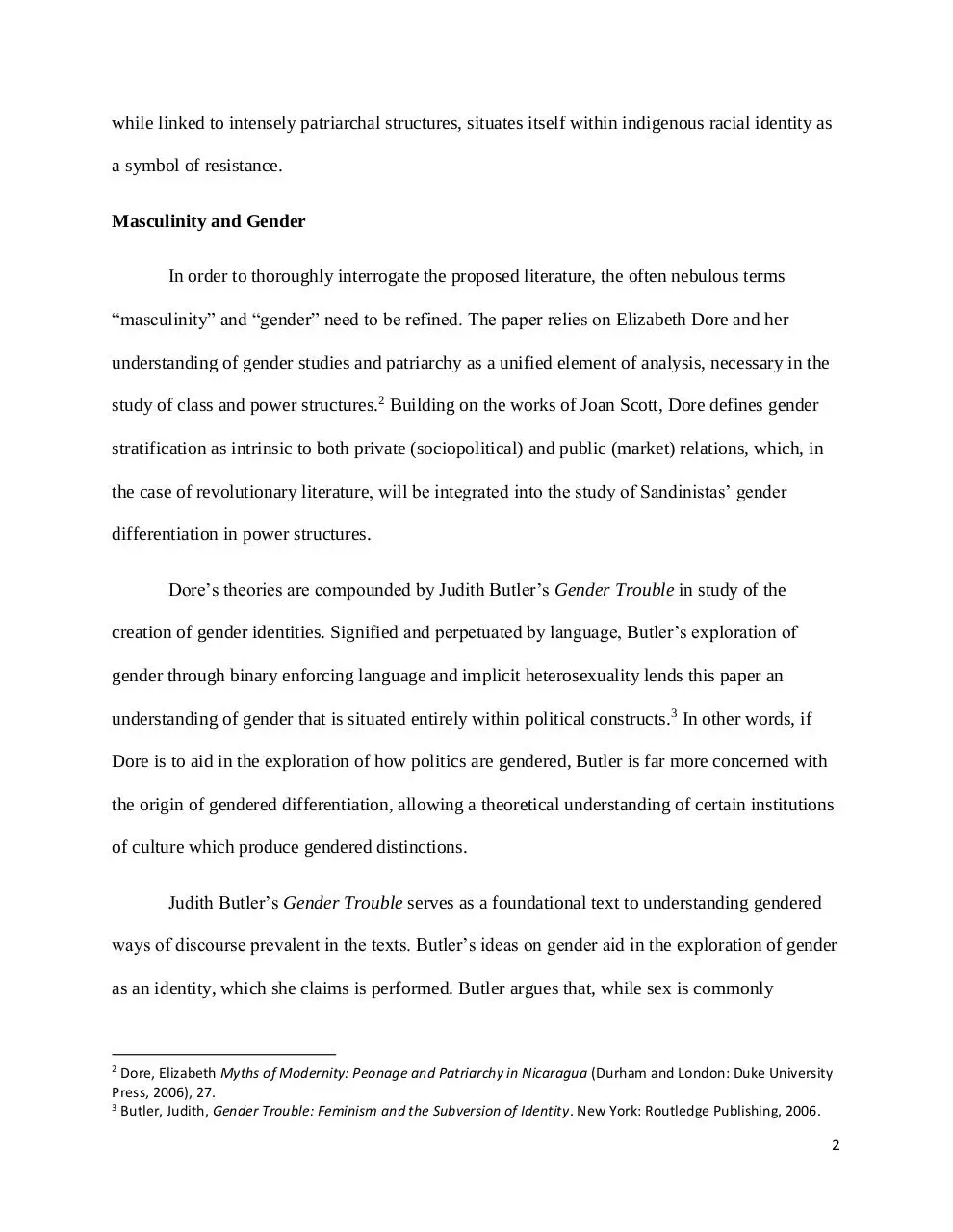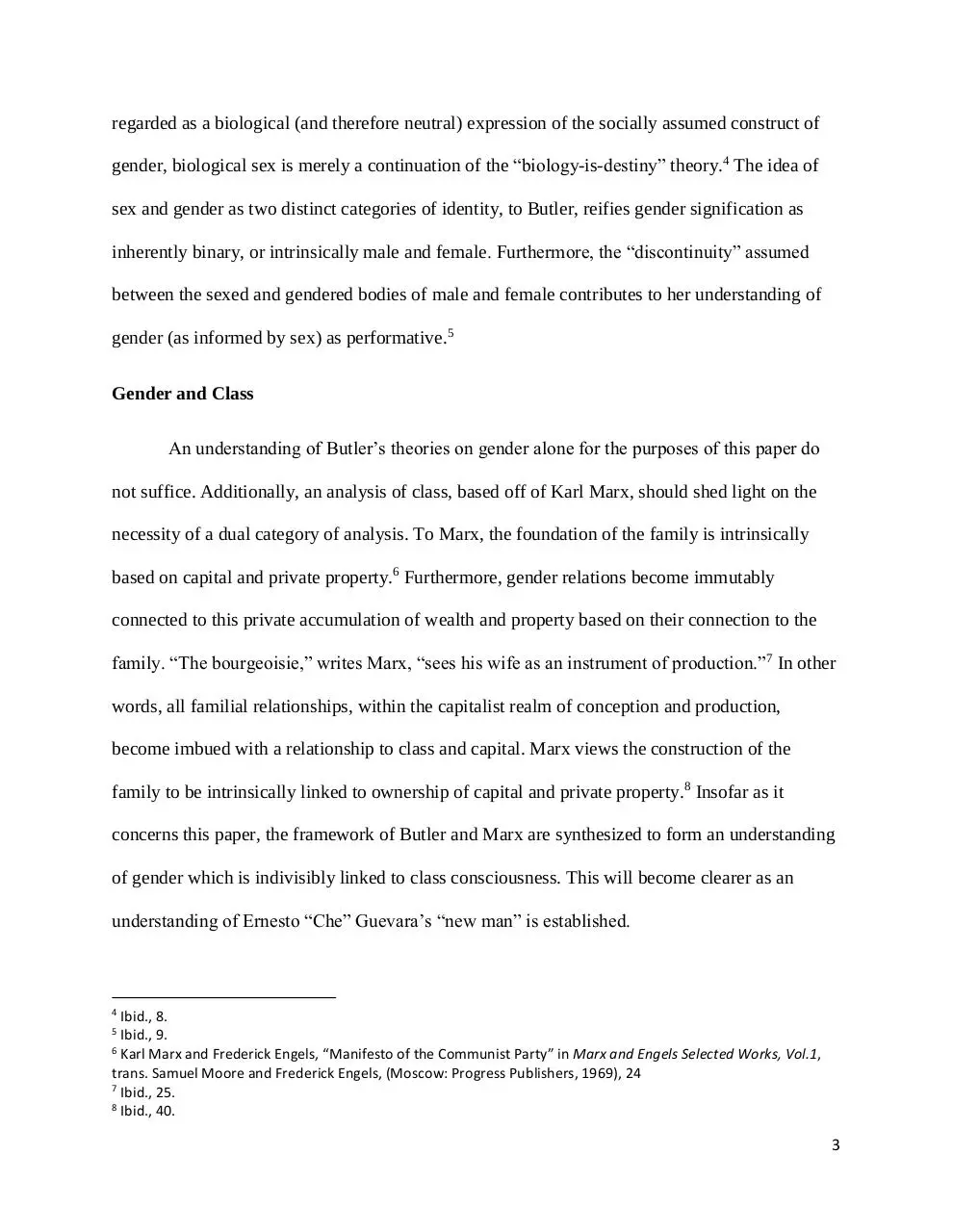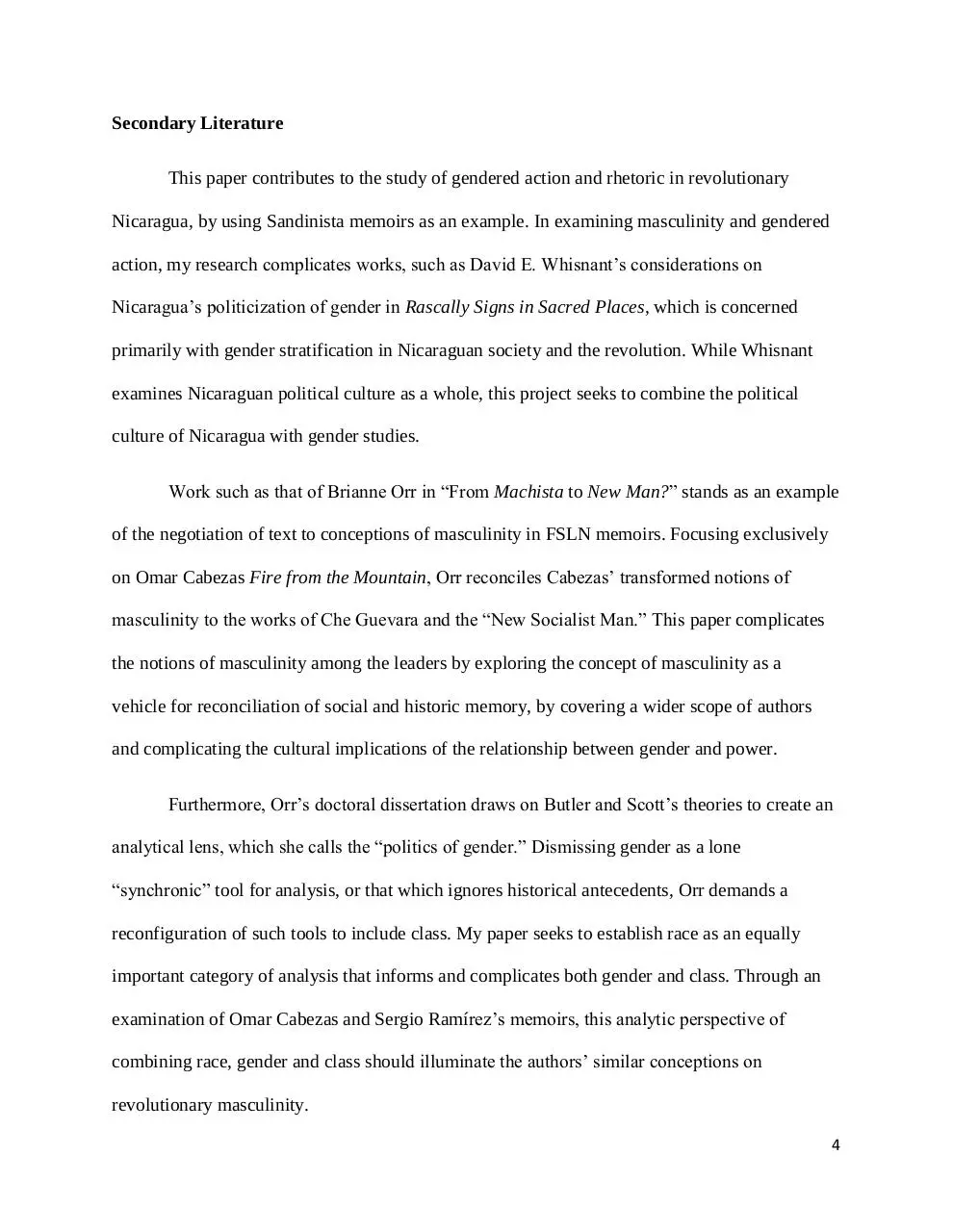LA Revolutionary Literature (PDF)
File information
Title: HETERONORMATIVE MASCULINITY IN LATIN AMERICAN REVOLUTIONARY LITERATURE: OMAR CABEZAS’ MALE TENDERNESS AND SERGIO RAMÃREZ’S PATRILINEAL REVOLUTIONARY FAMILY
This PDF 1.5 document has been generated by Microsoft® Word 2013, and has been sent on pdf-archive.com on 19/07/2016 at 23:53, from IP address 73.42.x.x.
The current document download page has been viewed 539 times.
File size: 609.26 KB (20 pages).
Privacy: public file





File preview
HETERONORMATIVE MASCULINITY IN LATIN
AMERICAN REVOLUTIONARY LITERATURE: OMAR
CABEZAS’ MALE TENDERNESS AND SERGIO
RAMÍREZ’S PATRILINEAL REVOLUTIONARY FAMILY
BAILEY LANGHAM
SENIOR THESIS: FLORIDA STATE UNIVERSITY
The Sandinista Revolution, which toppled the dynastic dictatorship of the Somoza family
that plagued Nicaragua for decades, characterized a long history of insurrection and empire in
the country’s history. Wrestling power from totalitarian dictators to emancipatory
revolutionaries, the Revolution of 1979 gave rise to the Frente Sandinista de Liberacíon
National, or Sandinista National Liberation Front (henceforth referred to as the “FSLN”). While
much can be said politically of the Sandinista revolution and subsequent eleven year
government, the interest of this paper lies in what Sandinistas themselves wrote of their own
revolution. Recognizing the limitations of autobiography and memoir as complete and accurate
portrayals of history, this paper seeks to understand revolutionaries’ conceptualizations of
gender, race and class through personal accounts of Nicaragua’s revolution.1 The concept of “the
new man,” hypothesized by Che Guevara, a Cuban revolutionary, became important to
Sandinista revolutionaries as they sought to reformulate bourgeoisie notions of masculinity
through revolutionary action.
While the Sandinista revolutionaries, in Omar Cabezas’ Fire from the Mountain and
Sergio Ramírez’s Adíos Muchachos, attempted to embody the concept of the “new man,” Their
memoirs promote a construction of the “revolutionary family” that, while ideologically linked to
the revolution, requires male lineage to be fully realized. “Revolutionary masculinity” is also
realized through a rejection of bourgeoisie masculine tropes, while at the same time realizing
masculinity through the physical reality of being male. This revolutionary masculine identity,
1
Joan Wallach Scott’s Gender and the History of Politics served as the basis for establishing gender as the focal
point of historical analysis, seeking to go beyond the usual interpretations of “women’s history” as history of the
family. Particularly influential, was “Gender: A Useful Category of Historical Analysis.” Joan Wallach Scott, Gender
and the Politics of History (New York: Columbia University Press, 1999).
1
while linked to intensely patriarchal structures, situates itself within indigenous racial identity as
a symbol of resistance.
Masculinity and Gender
In order to thoroughly interrogate the proposed literature, the often nebulous terms
“masculinity” and “gender” need to be refined. The paper relies on Elizabeth Dore and her
understanding of gender studies and patriarchy as a unified element of analysis, necessary in the
study of class and power structures.2 Building on the works of Joan Scott, Dore defines gender
stratification as intrinsic to both private (sociopolitical) and public (market) relations, which, in
the case of revolutionary literature, will be integrated into the study of Sandinistas’ gender
differentiation in power structures.
Dore’s theories are compounded by Judith Butler’s Gender Trouble in study of the
creation of gender identities. Signified and perpetuated by language, Butler’s exploration of
gender through binary enforcing language and implicit heterosexuality lends this paper an
understanding of gender that is situated entirely within political constructs.3 In other words, if
Dore is to aid in the exploration of how politics are gendered, Butler is far more concerned with
the origin of gendered differentiation, allowing a theoretical understanding of certain institutions
of culture which produce gendered distinctions.
Judith Butler’s Gender Trouble serves as a foundational text to understanding gendered
ways of discourse prevalent in the texts. Butler’s ideas on gender aid in the exploration of gender
as an identity, which she claims is performed. Butler argues that, while sex is commonly
2
Dore, Elizabeth Myths of Modernity: Peonage and Patriarchy in Nicaragua (Durham and London: Duke University
Press, 2006), 27.
3
Butler, Judith, Gender Trouble: Feminism and the Subversion of Identity. New York: Routledge Publishing, 2006.
2
regarded as a biological (and therefore neutral) expression of the socially assumed construct of
gender, biological sex is merely a continuation of the “biology-is-destiny” theory.4 The idea of
sex and gender as two distinct categories of identity, to Butler, reifies gender signification as
inherently binary, or intrinsically male and female. Furthermore, the “discontinuity” assumed
between the sexed and gendered bodies of male and female contributes to her understanding of
gender (as informed by sex) as performative.5
Gender and Class
An understanding of Butler’s theories on gender alone for the purposes of this paper do
not suffice. Additionally, an analysis of class, based off of Karl Marx, should shed light on the
necessity of a dual category of analysis. To Marx, the foundation of the family is intrinsically
based on capital and private property.6 Furthermore, gender relations become immutably
connected to this private accumulation of wealth and property based on their connection to the
family. “The bourgeoisie,” writes Marx, “sees his wife as an instrument of production.”7 In other
words, all familial relationships, within the capitalist realm of conception and production,
become imbued with a relationship to class and capital. Marx views the construction of the
family to be intrinsically linked to ownership of capital and private property.8 Insofar as it
concerns this paper, the framework of Butler and Marx are synthesized to form an understanding
of gender which is indivisibly linked to class consciousness. This will become clearer as an
understanding of Ernesto “Che” Guevara’s “new man” is established.
4
Ibid., 8.
Ibid., 9.
6
Karl Marx and Frederick Engels, “Manifesto of the Communist Party” in Marx and Engels Selected Works, Vol.1,
trans. Samuel Moore and Frederick Engels, (Moscow: Progress Publishers, 1969), 24
7
Ibid., 25.
8
Ibid., 40.
5
3
Secondary Literature
This paper contributes to the study of gendered action and rhetoric in revolutionary
Nicaragua, by using Sandinista memoirs as an example. In examining masculinity and gendered
action, my research complicates works, such as David E. Whisnant’s considerations on
Nicaragua’s politicization of gender in Rascally Signs in Sacred Places, which is concerned
primarily with gender stratification in Nicaraguan society and the revolution. While Whisnant
examines Nicaraguan political culture as a whole, this project seeks to combine the political
culture of Nicaragua with gender studies.
Work such as that of Brianne Orr in “From Machista to New Man?” stands as an example
of the negotiation of text to conceptions of masculinity in FSLN memoirs. Focusing exclusively
on Omar Cabezas Fire from the Mountain, Orr reconciles Cabezas’ transformed notions of
masculinity to the works of Che Guevara and the “New Socialist Man.” This paper complicates
the notions of masculinity among the leaders by exploring the concept of masculinity as a
vehicle for reconciliation of social and historic memory, by covering a wider scope of authors
and complicating the cultural implications of the relationship between gender and power.
Furthermore, Orr’s doctoral dissertation draws on Butler and Scott’s theories to create an
analytical lens, which she calls the “politics of gender.” Dismissing gender as a lone
“synchronic” tool for analysis, or that which ignores historical antecedents, Orr demands a
reconfiguration of such tools to include class. My paper seeks to establish race as an equally
important category of analysis that informs and complicates both gender and class. Through an
examination of Omar Cabezas and Sergio Ramírez’s memoirs, this analytic perspective of
combining race, gender and class should illuminate the authors’ similar conceptions on
revolutionary masculinity.
4
This rebel masculinity attempts to resist machista personification, which Orr describes as
“a self-perpetuated myth, an unreachable masculine model.” Simultaneously, however,
revolutionary gender is configured as an automated binary, relying on heteronormative models to
signify the adherence to gender constructs differing from bourgeoisie masculinity. In Omar
Cabeza’s Fire from the Mountain revolutionary masculinity is pitted against the bourgeoisie
masculinity of the National Guard. Sergio Ramírez endows his configurations of revolutionary
masculinity with elements of class and race, which result in a patrilineal revolutionary familial
model. Relying on Butler’s theories, an analysis of both Cabezas and Ramírez reveals that each
author situates the purported “new man” of the revolution, which of course also signifies
themselves, within the constructs of binary heteronormativity.9
Orr’s stated goal is to read Che dialectically through other Latin American revolutionary
texts.10 As she traces interpretations of Che’s “new manhood” throughout different guerrilla
literature of the 20th century, her analysis becomes much more about the presence of Guevara in
the literature than an analysis of gender and class as it pertains to the new code of revolutionary
manhood. By reading Che in and throughout her chosen literary corpus, Orr suggests that a break
with the “male code” of gender differentiation is achieved by a complete break with the
corporeality associated with gender binaries. This she finds present in Omar Cabezas’ Fire from
the Mountain, one of the texts I have chosen to analyze. Contrary to Orr, my reading of Cabezas’
text does not find a break with masculinity associated and realized through physical maleness,
but a redefined masculinity, imbued with class and race consciousness, that is intrinsically
9
Binary heteronormativity refers to the assumption that men and women always engage in heterosexual
relationships.
10
Brianne Orr “Cracking the Code: The Politicization of Gender in Latin American Guerrilla Literature,” (PhD diss.,
Michigan State University, 2009), 2.
5
situated within a heteronormative construction of the body. Furthermore, my research does not
seek to find Che within Cabezas’ and Ramírez’s memoirs, but use the authors’ internalization of
Che’s new man as an autonomous point of theoretical reference.
Ernesto “Che” Guevara’s “New Man” and Omar Cabezas’ Masculine Corporeality
Guevara, as outlined in “From Algiers, for Marcha,” sees the social formation of class as
inherently linked to capitalist modes of production, asserting that individuals are educated by
society and “self-educated” by a system of social controls that seeks to isolate the individual.11
“To build communism,” he writes “is necessary…to build the new man and woman.”12 Imbued
with class consciousness, the “new man” will correct the institutionalization of social norms that
developed under capitalism.13 The idea of the new man, aware and self-educated against the
social reproductions of capitalism, is found in Omar Cabezas’ Fire from the Mountain, where his
unremitting goal of “[being] like Che” is supposedly realized through paternalistic family
structures and endurance of the physical body in guerrilla activity.
Orr proposes Cabezas’ conception of manhood changes in three distinct spaces, related to
the city, the mountain and his ascent from the mountain.14 By no means did Cabezas’
formulation of masculinity, as it is informed by race and class, remain static during his narration.
I perceived, in contrast to Orr’s assertions, Cabezas’ changes to be fixated entirely within a
heteronormative binary. Although continually fixated within corporeal masculinity and
paternalistic family structures, Cabezas distinguishes revolutionary masculinity from bourgeoisie
masculinity.
11
Guevara, 4.
Ibid.
13
Ibid., 7-8.
14
Orr, 90.
12
6
While training in the mountain, Cabezas and his fellow campañeros lug around incredibly
heavy sacks as they hike up and down mountainous terrain. In a moment of defeat, the army
decides to go no further, to the chagrin of their military leader and trainer, Tello. In an effort to
mobilize the men, Tello tells the men “you’ve heard talk of the new man...do you know where he
is? He’s there on the ridge at the top of the hill we’re climbing.”15 Placing the achievement of the
new man within the grasps of the men, Tello’s words ignite within Cabezas an understanding of
the new man that is founded within physical endurance, specifically that which is dedicated to
revolutionary actions. “To give more than the typical man…to kill the old man,” within
themselves, is to unlock the physical capabilities of the body, to continue climbing through
exhaustion.16 The new man, in this instance to Cabezas, is only found within the revolutionary if
it is achieved through the physical act of endurance. While the new man “can generate a whole
society of new men,” the vanguard of this revolutionary process has its origins in physicality.
The origin of the new man, to Cabezas, was “in the FSLN…with fungus infections and with his
feet oozing worms; the new man begun to be born with loneliness and eaten alive by
mosquitos.”17 In other words, the origin of the new man was found in a redefined masculinity,
guerrilla masculinity. This guerrilla masculinity was situated within the corporeal realization of
masculinity.
Male Tenderness
Guerrilla masculinity, while still situated within a heteronormative matrix of
identification, resisted individualism in favor of communalism, found in Omar Cabezas’
15
Cabezas, Omar. Fire from the Mountain: The Making of a Sandinista, trans. Kathleen Weaver. (New York: Plume
Publishing, 1985) 92.
16
Ibid., 94.
17
Ibid., 87.
7
narrative as “male tenderness.” “Male tenderness,” to Cabezas furthered definitions of
masculinity perpetuated by physical strength and endurance, relying on resistance to the
individualism produced and reinforced by capitalism. To Cabezas, this communal love was
developed “through action” to produce “a spirit of iron, a spirit of steel, a contingent of men that
was morally and mentally indestructible.”18 References to iron and steel unsurprisingly relate the
affection, a character trait generally denoted as female, of the guerrillas to stereotypically
masculine elements as a reference to physicality. Beyond reference to strength found in the body
alone, iron and steel represent the link formed between physical and mental guerilla masculinity.
“Extremely tough and hardened,” Cabezas explains, “fraternal love,” arose due to the physical
strain exerted by the men on the mountain. Cabezas’ reformulation is significant because this
tenderness did not arise in spite of physical exertion, but because of it, articulating masculinity,
even its “feminine” expression, in terms of masculine physicality. However important to the
revolution, Cabezas made absolutely clear this “tenderness” was not mistaken for homosexuality.
Heterosexuality acted as an equally vital component of guerrilla masculinity.
Described as a sort of “gruff affection,” communal male tenderness sought to dismantle
individualism, transforming “loneliness into a brotherhood,” creating a class conscious definition
of affection. If “building socialism…is characterized by the abolition of the individual,” the male
tenderness expressed by Cabezas represented a class conscious reformulation of masculinity that
fit within Guevara’s new masculine identity.19 This contingent of men, to Cabezas, was “capable
of mobilizing the entire society against the dictatorship.”20 In other words, the new men
developing the communal affection within revolutionary spirit on the mountain represented the
18
Ibid., 86.
Guevara, 1.
20
Cabezas, 85.
19
8
Download LA Revolutionary Literature
LA Revolutionary Literature.pdf (PDF, 609.26 KB)
Download PDF
Share this file on social networks
Link to this page
Permanent link
Use the permanent link to the download page to share your document on Facebook, Twitter, LinkedIn, or directly with a contact by e-Mail, Messenger, Whatsapp, Line..
Short link
Use the short link to share your document on Twitter or by text message (SMS)
HTML Code
Copy the following HTML code to share your document on a Website or Blog
QR Code to this page

This file has been shared publicly by a user of PDF Archive.
Document ID: 0000402130.